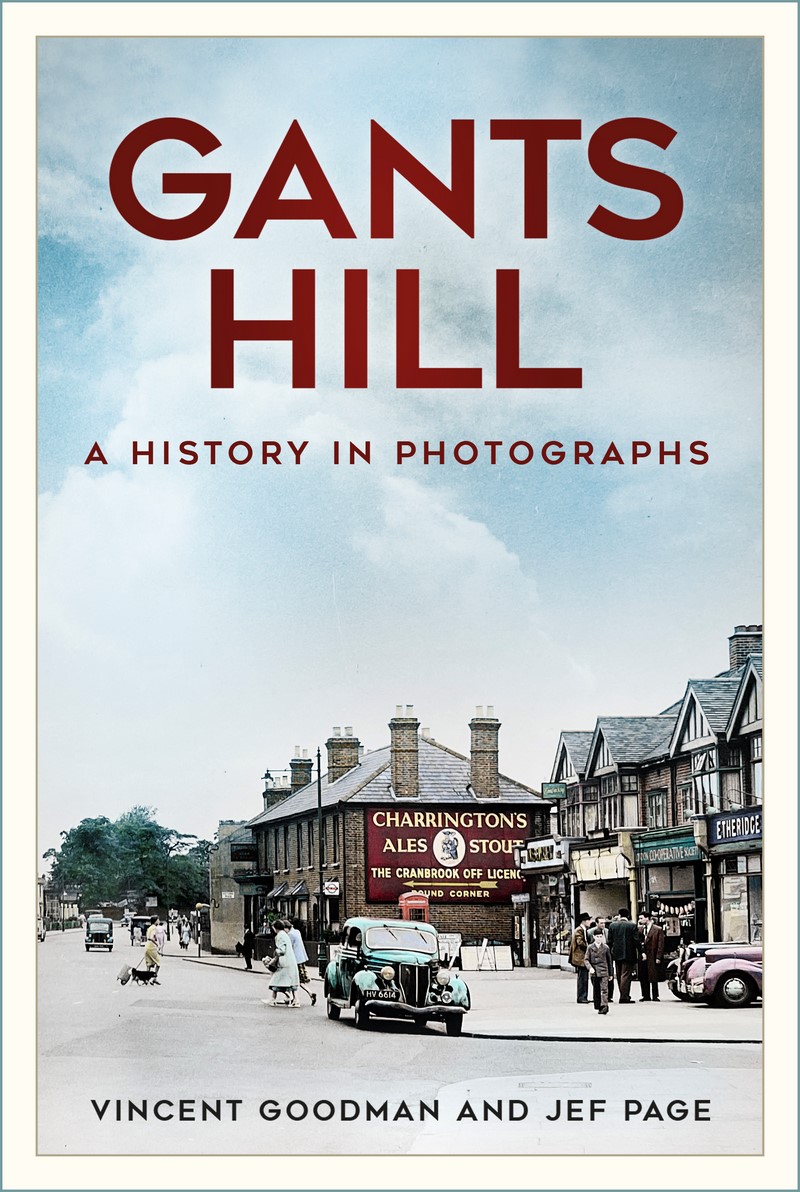
“GANTS HILL – A HISTORY IN PHOTOGRAPHS”
by Vincent Goodman and Jef Page – Published by The History Press
Published May 2023
This is the first photographic history book focussing on Gants Hill, illustrating in detail how the farmland of the early 1900s seemed to transform in a few years into a major commuter suburb. The book contains over 180 carefully selected photographs, and a history of the area.
History
There are two possible explanations for the origin of the name Gants Hill. It could derive from the le Gant family. Gantesgrave appears as early as 1291. In 1321 Ralph le Gant was steward of Barking Abbey, and Richard and Gilbert le Gant were stewards in 1456. There are also theories that the name derives from Gnats Cross*. The area was originally a swamp and was the habitat of swarms of flying insects otherwise known as gnats. Wealthy local landowner Lord Parham had the area drained in 1803 and the village that sprung up in this area became known as Gnat’s Cross. This changed to Hill due to cases of religious discrimination. Gnat’s probably became Gants due to a printing error in the reproduction of local maps.
* Thank you to Norman Lewis for this information
Gants Hill is a borough of Ilford – originally Yleford – the ford through the River Hyle (meaning trickling stream). Hyle is the Anglo Saxon name for Roding. Ilford is in the south east county of Essex, appearing originally as East Seaxe (the East Saxons) in 604, and as Excessa in the Domesday book.
Gants Hill was originally a small settlement on the main London to Colchester/ Chelmsford/ Norwich road and soon became a crossroads for travellers and day tripping Victorians cycling from East London to the nearby Epping Forest.
Cranbrook Road once continued without interruption from Barkingside to Ilford. However when Eastern Avenue was built in the mid 1920s, the area at the junction gradually took on urban aspects with shops, offices, banks, a cinema and the tube station on the Central Line extension. In its early years Eastern Avenue was a peaceful backwater with little traffic except at weekends and holidays, when everyone with a car made the journey to Southend.
The famous Gants Hill roundabout first appeared around 1928 and later the Underground Station was built underneath in the 1930’s. Work was suspended at the outbreak of World War II and the already built tube tunnel was used as an air-raid shelter and by Plessey Ltd for munitions production from 1940-1945. The line was completed by London Underground in 1947.
The Savoy Cinema was opened on 3rd September 1934 and originally seated 1726 people. It became the Odeon in 1949 and has since been converted into a multi screen theatre. Sadly the Odeon closed it’s doors for the final time in March 2002 and was demolished in March 2003.
Famous faces to have come from the area include singer Louise Wener, actress Louise Lombard (House of Elliot), actor David Rappaport, athlete Tessa Sanderson, cricketer Nasser Hussein (attended Ilford County High School) and boxer Nigel Benn.
Footballer Bobby Moore lived in Glenwood Gardens, footballer and ex-England manager Terry Venables lived in Beechville Gardens (thank you to David Hahn for this information), Rick Wakeman rented a bedsit in Gants Hill in the 1960s. Other famous faces include songwriter Adrian (Classic) Gurvitz, singer Kathy Kirby, journalist Richard Littlejohn, actress Tamsin Outhwaite, TV presenter Jenny Powell and comedian Simon Amstell. Bands Squeeze, Hawkwind and Ian Dury & The Blockheads famously played at The Odeon Gants Hill in the late 1970s.
Contact Us
Contact Us
Join our Gants Hill Facebook Group
432 Cranbrook Road, Gants Hill, Ilford, Essex IG2 6LL
Tel: 020 8518 6131
Email: info@speedprint.co.uk
www.speedprint.co.uk

